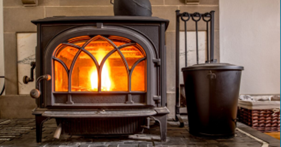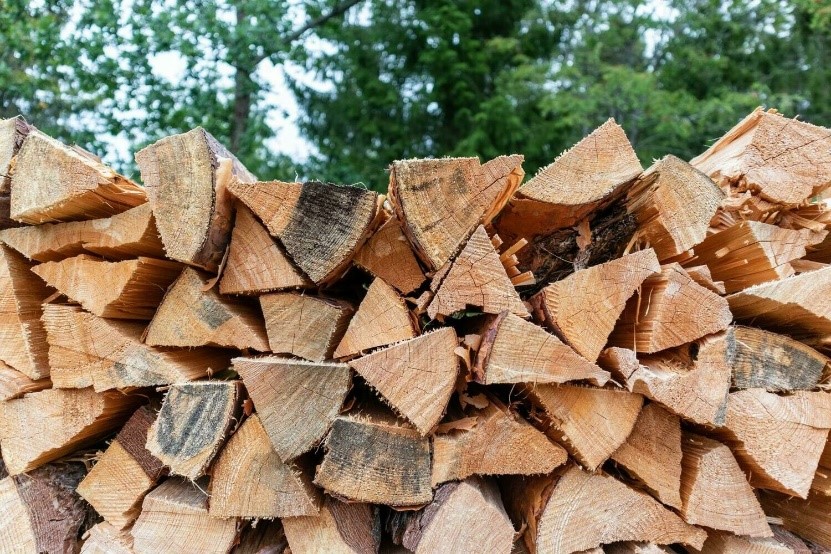07 Nov Safety Tips for using a Wood Burning Stove in your Tiny House
Wood burning stoves can be a great source of heat in a tiny house, but safety should always be a top priority.
Did You Know?
The largest source of fire in Canadian homes comes from fuel burning appliances. The main causes of fire include: inadequate clearance between the wood burner and walls, floors and furniture; creosote buildup in the chimney; poorly or improperly installed chimneys and improper installation of the wood burner itself.
What is a wood stove?
A wood stove, also known as a fireplace or simply a stove, is an enclosed space in which fuel is burned to provide heating. It differs from a fire place by its smaller size and primary purpose of heat-only production rather than accessory use for cooking and/or ambience. Wood stoves are commonly used for heating a dwelling.

Stay Safe! Here are some important safety tips to consider when using a wood burning stove in a tiny house:
Proper Installation: Ensure that your wood burning stove is installed correctly by a qualified professional. Follow all manufacturer guidelines and local building codes. Proper venting and clearance requirements are crucial to prevent fires and carbon monoxide poisoning.
Clearances: Maintain proper clearances between the wood stove and any combustible materials, such as walls, floors, furniture, and curtains. Check the manufacturer’s recommendations for the specific model you have.
Use the Right Fuel and Only Burn Clean Wood
Only burn dry, seasoned wood in your wood stove. Wet or green wood can produce excess creosote, which can lead to chimney fires. It can be tempting to burn different kinds of wood, but burning anything other than clean wood can be dangerous. For example, pressure-treated wood, when burnt, can cause arsenic fumes which are poisonous. When it comes to wet wood, it causes an excessive amount of smoke which is neither healthy for your lungs nor for the wood-burning stove.

Regular cleaning and maintenance
Clean your wood stove and chimney regularly to remove creosote buildup, ashes, and debris. This helps prevent chimney fires and ensures efficient burning.
More on Cleaning Your Wood Stove
A clean wood stove is essential to burn cleanly and efficiently, thus providing more heat with less pollution.
- Unplug your wood stove from the power source before beginning any cleaning process.
- Scrub all surfaces with soap and water or other appropriate cleaner.
- Wipe clean window area with glass cleaner.
- Remove ash pan and clean it separately (You can also purchase an ash bucket that will allow easier removal of ashes without having to empty out the entire stove).
- Vacuum clean around edges using brush attachment or crevice tool on vacuum cleaner.
Use a clean towel to clean stove top
If your ash pan is removable, you can use the vacuum cleaner brush attachment or crevice tool to go around the edges of your stove and clean up any dust that may have accumulated. If not, then just wipe down with soap and water (or whatever cleaning agent you prefer) using a clean towel. Be sure to clean the window area as well and wipe it down with glass cleaner. You can then replace your ash pan or empty out any ashes that you’ve collected into a bucket for disposal.
Install smoke and carbon monoxide detectors: Install both smoke detectors and carbon monoxide detectors in your tiny house. Check their batteries regularly and replace them as needed.
Fire extinguisher: Keep a fire extinguisher nearby and know how to use it in case of an emergency. If your tiny home is Noah Certified, you know exactly where your fire extinguisher is. Within 2 feet of your front door attached to the wall.
Supervise children and pets: If you have children or pets in the tiny house, be mindful of the stove’s hot surface and keep a safety gate or barrier around the stove to prevent accidental burns.
Adequate ventilation: Ensure your tiny house has sufficient ventilation to allow fresh air to enter while the stove is in use. This helps prevent a buildup of carbon monoxide.
Never leave the stove unattended: Always attend the wood stove while it is burning. Never leave the house or go to sleep with the stove still lit.
Have an escape plan: In the event of a fire, make sure you and everyone in the tiny house knows the escape routes and have a designated meeting place outside.
Consider a spark arrester: If you have a chimney that extends outside of the tiny house, consider installing a spark arrester to prevent embers from escaping and potentially causing a fire.
Remember, the safety of a wood burning stove in a tiny house is not just about installing it correctly but also adopting responsible practices when using it. By following these safety tips and using the wood stove with caution, you can enjoy the warmth and ambiance it provides without compromising safety. Not to mention lowering your electricity bill!

Sorry, the comment form is closed at this time.